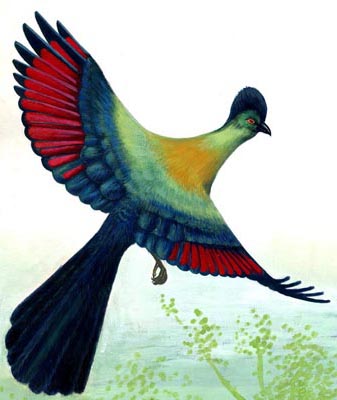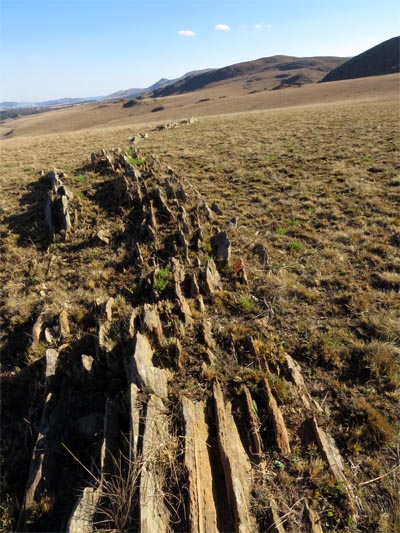The ENTC now has a new website, at www.entc.org.sz
Our logo is adapted from a painting by Phillip Dlamini, 1998, of a purple crested turaco. In traditional Swazi dress, the red feathers feature in the royal headdress, so this bird illustration is not only a symbol for wildlife conservation, but also of cultural heritage.



The dramatic nature of the scenery at Malolotja is a product of the underlying rocks and the different types of erosion which have acted upon the different rock types. The Lochiel Granite, near the eastern border of the reserve at the entrance has eroded in some cases into huge domes of rock and others into boulder heaps, or tors, scattered on the bare upland surface. Over the many millions of years since it was formed the vast mass of granite has become stressed and fractured, allowing moisture to penetrate into the rock and to rot its susceptible minerals through hydration and oxidation. Now it has finally appeared at the surface, streams and rivers are etching away the rotted weathered material which is being carried away to become the clays and sands of the river valleys, leaving the resistant "core" of the granite behind. The resistant edges of the rocks have formed massive convex domes which can be seen to the east of Nkomati Viewpoint. However, the incidence of gulleys along the east slope of Mbulukudvu Valley i.e. the edge of the granite may be the result of weathering along the baked margin of the granite. Around the entrance and picnic and cabin sites, boulders lie in heaps. These are the tors and represent the resistant core boulders lowered into their present position as the land surface has been eroded. They now form fire-resistant enclaves where trees can grow. These areas are in dolerite/gabbro dikes which in most cases is more resistant to erosion than the granite, an exception being the upper Majolomba valley below the road crossing where the stream follows the dike.

Turning to the Swaziland Supergroup rocks, the different hardness and softness of these rocks are the cause of the broken, mountainous terrain and deep, sheltered ravines which characterize the reserve. The chemically and physically weaker shales and schists are often deeply rotted and erode easily, whereas some of the quartzites are chemically extremely hard and resistant. The soapstones form gentle slopes and in comparison to the quartzites, are rarely exposed. Good exposures can be seen at the soapstone quarry above Malolotja Vlei. Because the two sorts of rock are often inter-bedded and are now sitting vertically out of the ground, the softer rocks are etched away into the deep valleys leaving the harder rocks like long walls in the landscape. These rock walls can be seen especially between the Malolotja River and Silotwane and again on the west side of Ngwenya. Usually they look like large ribs, running from north to south. Occasionally, the rivers have broken through one of these resistant ridges, creating pools and waterfalls, for example at the Mahulungwane Falls, Majolomba Gorge and Forbes Reef gorge.
As you stand on the high ground in the eastern part of the reserve, and look towards the west, ridge upon ridge of mountains can be seen. They appear now as separate, jagged, upstanding peaks. Ignoring the valleys in between they seem to form a flat, high plane, dipping towards the east. This phenomenon of accordant summits is all that is left of a very ancient, very widespread featureless flat plain. This ancient plain existed here some twenty five million years ago and is known as the "African Surface". Remnants can all be reconnected by an imaginary flat surface today. Even in Swaziland, you can see other remnants of the Surface in the north east of the country within Mlawula Nature Reserve on top of the Lubombo Mountains. The flat top of the Lubombo, if projected westwards, links with these remnants at Malolotja, to which it was once joined.
Beneath the African Surface, weathering was constantly taking place, deeply in the chemically weak rocks, but hardly at all in the resistant quartzites. During the last twenty five million years, enormous pressure in the earth's crust has pushed the African continent upwards, rejuvenating all the rivers and bringing about new cycles of erosion. The drainage has washed and scoured out the pre-weathered, rotten rock particles, leaving the ranges of the harder rocks as a skeleton, the remnants of the ancient surface of Africa. Evidence of rejuvenation is seen at Forbes Reef where the Malolotja River has captured the headwaters of the Mbuluzi River. The Malolotja generally flows south west from the entrance area of the park, makes a westward turn at Forbes Reef, the area of capture, and northwards below the gorge here to the Nkomati.
Our Contacts:
Head Quarters: (+268) 2416 1489/1179
Email: info@sntc.org.sz
King Sobhuza II Park: (+268) 2416 1489/1179
Email: ksmp@sntc.org.sz
National Museum: (+268) 2416 1489/1179
Email: curator@sntc.org.sz
Copyright © ESWATINI NATIONAL TRUST COMMISSION
Malolotja Nature Reserve: (+268) 2444 3241 / (+268) 2416 1480
Email: culturalvillage@sntc.org.sz
Mantenga Nature Reserve and Swati Cultural Village: 2416 1151/1178
Email: culturalvillage@sntc.org.sz
Mlawula Nature Reserve: (+268) 2383 8885 (Reception)
(+268) 2383 8453 (Senior Warden)
Email: culturalvillage@sntc.org.sz
Magadzavane Lodge: (+268) 2343 5108/9
Email: magadzavane@sntc.org.sz